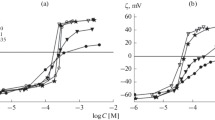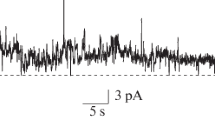Abstract
Polycationic amino acids induce the leakage and fusion of liposomes containing anionic lipids. We have investigated the nature and extent of the changes in membrane physical properties caused by these polypeptides which could result in the observed membrane destabilization. We found that in the range of pH 5 to pH 7 both poly-l-histidine and poly-l-lysine were ineffective in shifting the bilayer to hexagonal phase transition temperature of dielaidoylphosphatidylethanolamine, either in the presence of absence of 1-palmitoyl-2-oleoylphosphatidylserine. We also studied the gel to liquid crystalline phase transition properties of 1∶1 mixtures of phosphatidylserine and phosphatidylethanolamine, both in dimyristoyl forms as well as the 1-palmitoyl-2-oleoyl forms, as a function of pH and in the presence and absence of polycationic amino acids. We observed that these two lipids were largely miscible at all pH values and in the presence and absence of the polypeptides. However, there was some increased tendency for phase separation at higher pH and in the absence of polypeptide. Thus neither changes in curvature strain nor lateral phase separation induced by the polycationic amino acids could account for their marked ability to induce leakage and fusion.
Phosphatidylethanolamine labelled with pyrene on one of the acyl chains gives rise to fluorescent emission from both monomer and excimer forms. The ratio of emission intensity from these two forms is indicative of lateral phase separation and the degree of lateral mobility of this probe. In equimolar mixtures of the 1-palmitoyl-2-oleoyl forms of phosphatidylserine and phosphatidylethanolamine in the liquid crystalline phase at 30 °C we find little effect of pH on the ratio of excimer to monomer emission intensity. However poly-l-lysine markedly lowers the fraction of excimer emission from these liposomes through the pH range from 5 to 7. Poly-l-histidine lowers the excimer to monomer emission ratio at pH 5 but not at pH 7. This is opposite to what one would expect for lateral phase separation and is interpreted at being the consequence of the polypeptide lowering the rate of lateral diffusion of the lipids. This effect of poly-l-histidine is observed over a range of temperatures from 0 to 40°C in both gel and liquid crystalline phases. There is no evidence from the behaviour of the pyrene fluorescent probe for lipid interdigitation. We conclude that the promotion of leakage and fusion in anionic liposomes by polycationic amino acids is not a result of large changes in the physical properties or arrangements of the lipids but rather to a surface binding of the polyamino acids.
Similar content being viewed by others
Abbreviations
- DSC:
-
differential scanning calorimetry
- DEPE:
-
dielaidoylphosphatidylethanolamine
- POPS:
-
1-palmitoyl-2-oleoylphosphatidylethanolamine
- DMPS:
-
dimyristoylphosphatidylserine
- DMPE:
-
dimyristoylphosphatidylethanolamine
- POPE:
-
1-palmitoyl-2-oleoylphosphatidylethanolamine
- TH :
-
bilayer to hexagonal phase transition temperature
- pyr-PE:
-
1-hexadecanoyl-2-(1-pyrenedecanoyl)-sn-glycero-3-phosphoethanolaline
- E/M:
-
ratio of intensities of excimer to monomer emission
References
Wang, C. -Y. and Huang, L. (1984)Biochemistry 23:4409–4416.
Uster, P. S. and Deamer, D. W. (1985)Biochemistry 24:1–8.
Bondeson, J. and Sundler, R. (1990)Biochim. Biophys. Acta 1026:186–194.
Cornut, I., Thiaudiere, E. and Dufourcq, J. (1993) in:The Amphipathic Helix (R. M. Epand, Ed.), CRC Press, Boca Raton, FL, pp. 173–219.
Epand, R. M., Epand, R. F., Richardson, C. D. and Yeagle, P. L. (1993)Biochim. Biophys. Acta 1152:128–134.
Epand, R. M. and Polozov, I. (1995) in:Nonmedical Applications of Liposomes (Y. Barenholz and D. Lasic, Eds) CRC Press, Boca Raton, FL (in press).
Tournois, H., Henseleit, U., DeGier, J., DeKruijff, B. and Haest, C. W. M. (1988)Biochim. Biophys. Acta 946:173–177.
Yaroslavov, A. A., Kul'kov, V. E., Polinsky, A. S., Baibakov, B. A. and Kabanov, V. A. (1994)FEBS Letters 340:121–123.
DeKruijff, B. and Cullis, P. R. (1980)Biochim. Biophys. Acta 601:235–240.
Silvius, J. R. and Gagne', J. (1984)Biochemistry 23:3232–3240.
Somerharju, P. J., Virtanen, J. A., Eklund, K. K., Vainio, P. and Kinnunen, P. K. L. (1985)Biochemistry 24:2773–2781.
Eklund, K. K., Vuorinen, J., Mikkola, J., Virtanen, J. A. and Kinnunen, P. K. J. (1988)Biochemistry 27:3433–3427.
Chong, P. L. -G., Tang, D. and Sugar, I. P. (1994)Biophysical Journal 66:2029–2038.
Galla, H. -J. and Sackmann, E. (1974)Biochim. Biophys. Acta 339:103–115.
Hresko, R. C., Sugar, I. P., Barenholz, Y. and Thompson, T. E. (1986)Biochemistry 25:3813–3823.
Lehtonen, J. Y. A. and Kinnunen, P. K. J. (1994)Biophysical Journal 66:1981–1990.
Komatsu, H. and Rowe, E. S. (1991)Biochemistry 30:2463–2470.
Stegmann, T., Schoen, P., Bron, R., Wey, J., Bartoldus, I., Ortiz, A., Nieva, J.-L. and Wilschut, J. (1993)Biochemistry 32:11330–11337.
Author information
Authors and Affiliations
Rights and permissions
About this article
Cite this article
Epand, R.M., Lim, W. Mechanism of liposome destabilization by polycationic amino acids. Biosci Rep 15, 151–160 (1995). https://doi.org/10.1007/BF01207455
Received:
Issue Date:
DOI: https://doi.org/10.1007/BF01207455




